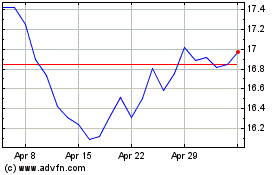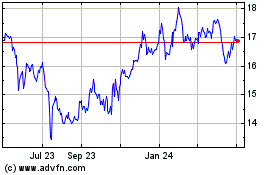AT&T's Pay-TV Subscribers Continue to Flee --update
April 24 2019 - 10:24AM
Dow Jones News
By Drew FitzGerald and Kimberly Chin
AT&T Inc.'s pay-TV subscriber base continued to erode during
the first quarter, adding pressure on the telecom and media giant's
project to develop a new streaming service aimed at
cord-cutters.
The Dallas company reported a net loss of 544,000 "premium" TV
customers, a category that includes DirecTV satellite subscriptions
and U-verse fiber optic packages, during the first three months of
the year. The online cablelike service DirecTV Now shed 83,000
customers.
The reported pay-TV losses would have been even deeper were it
not for a change in the way AT&T records disconnections. The
company said it now counts severed accounts based on billing
cycles, a change that boosted total pay-TV subscriptions by
117,000. All told, the company ended the quarter with 23.9 million
pay-TV connections.
"We'll continue to see declines in traditional TV subs,
particularly those areas where we can't bundle with broadband,"
Chief Executive Randall Stephenson said in a conference call with
analysts. "You'll see subscriber losses should lessen as we get
into 2020."
In its wireless business, AT&T said it added 80,000 more
"postpaid" phone subscriptions, a valuable category of customers
who tend to stick around longer. Rival Verizon Communications Inc.
said Tuesday it lost 44,000 such connections. The customer gains
boosted earnings despite declining revenue from smartphone
upgrades, which hit a "record low" during the quarter. Cellphone
users have been holding on to their devices for longer, a trend
that has forced carriers to adapt.
Overall, merger-amortization costs and integrated-relation
expenses weighed on its profit for the quarter ended March 31. Net
income attributable to AT&T totaled $4.01 billion, or 56 cents
a share, compared with $4.76 billion, or 75 cents a share, a year
earlier. Analysts polled by Refinitiv expected 60 cents a share.
Meanwhile, adjusted per-share earnings were 86 cents, in line with
analysts' expectations.
Consolidated revenue jumped 18% to $44.8 billion, primarily from
its Time Warner acquisition.
AT&T closed its purchase of the owner of Warner Bros., HBO
and a suite of cable channels including CNN last year after a
protracted antitrust battle with the U.S. Department of Justice.
The business, renamed WarnerMedia, added $1.2 billion in operating
income to the bottom line last quarter.
Results in the company's media division benefited from cost
cutting and higher revenue from Warner Bros.-produced TV series and
movies, including continuing box office sales from "Aquaman."
WarnerMedia is building an on-demand streaming video service
expected to launch in "beta" mode near the end of this year. The
still unnamed service, which wouldn't carry the live sports and
news available on DirecTV Now, is slated to join an increasingly
crowded market for internet-based entertainment that includes new
offerings from Walt Disney Co. and Apple Inc.
"The Disney announcement gave us nothing but more optimism in
terms of what we'll be able to bring to market," Mr. Stephenson
said Wednesday. WarnerMedia plans to reveal more details about its
plans in September or October.
Shares of the company fell about 3% in early trading. The stock
is still up nearly 10% this year.
Write to Drew FitzGerald at andrew.fitzgerald@wsj.com and
Kimberly Chin at kimberly.chin@wsj.com
(END) Dow Jones Newswires
April 24, 2019 10:09 ET (14:09 GMT)
Copyright (c) 2019 Dow Jones & Company, Inc.
AT&T (NYSE:T)
Historical Stock Chart
From Mar 2024 to Apr 2024

AT&T (NYSE:T)
Historical Stock Chart
From Apr 2023 to Apr 2024
